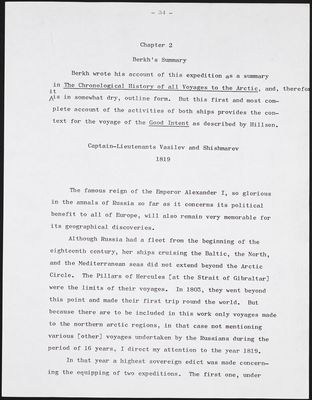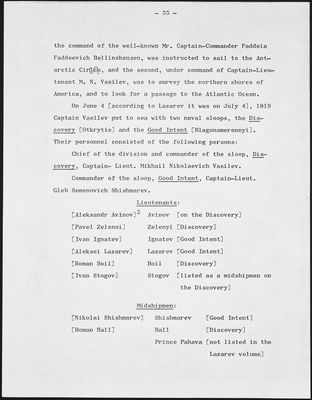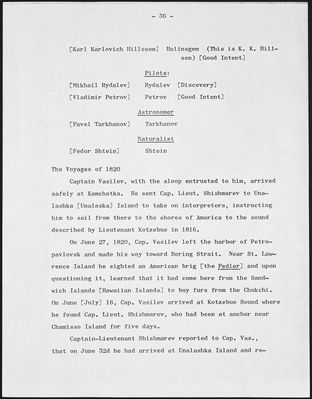Pages
mss142-vasilevShishmarev-i2-001
- 34 -
Chapter 2
Berkh's Summary
Berkh wrote his account of this expedition as a summary in The Chronological History of all Voyages to the Arctic, and, therefor it is in somewhat dry, outline form. But this first and most complete account of the activities of both ships provides the context for the voyage of the Good Intent as described by Hillsen.
Captain-Lieutenants Vasilev and Shishmarev 1819
The famous reign of the Alexander I, so glorious in the annals of Russia so far as it concerns its political benefit to all of Europe, will also remain very memorable for its geographical discoveries.
Although Russia had a fleet from the beginning of the eighteenth century, her ships cruising the Baltic, the North, and the Mediterranean seas did not extend beyond the Arctic Circle. The Pillars of Hercules [at the Strait of Gibraltar] were the limits of their voyages. In 1803, they went beyond this point and made their first trip around the world. But because there are to be included in this work only voyages made to the northern arctic regions, in that case not mentioning various [other] voyages undertaken by the Russians during the period of 16 years, I direct my attention to the year 1819.
In that year a highest sovereign edict was made concerning the equipping of two expeditions. The first one, under
mss142-vasilevShishmarev-i2-002
- 35 -
the command of the well-known Mr. Captain-Commander Faddeia Faddeevich Bellinshauzen, was instructed to sail to the Antarctic Circle, and the second, under command of Captain-Lieutenant M. N. Vasilev, was to survey the northern shores of America, and to look for a passage to the Atlantic Ocean.
On June 4 [according to Lazarev it was on July 4], 1819 Captain Vasilev put to sea with two naval sloops, the Discovery [Otkrytie] and the Good Intent [Blagonamerennyi]. Their personnel consisted of the following persons:
Chief of the division and commander of the sloop, Discovery, Captain- Lieut. Mikhail Nikolaevich Vasilev.
Commander of the sloop, Good Intent, Captain-Lieut. Gleb Semenovich Shishmarev.
| Lieutenants: | ||
|---|---|---|
| [Aleksandr Avinov]2 | Avinov | [on the Discovery] |
| [Pavel Zelenoi] | Zelenyi | [Discovery] |
| [Ivan Ignatev] | Ignatev | [Good Intent] |
| [Aleksei Lazarev] | Lazarev | [Good Intent] |
| [Roman Boil] | Boil | [Discovery |
| [Ivan Stogov] | Stogov | [listed as a midshipman on |
| the Discovery] |
| Midshipmen: | ||
|---|---|---|
| [Nikolai Shishmarev] | Shishmarev | [Good Intent] |
| [Roman Hall] | Hall | [Discovery] |
| Prince Pahava | [not listed in the | |
| Lazarev volume] |
mss142-vasilevShishmarev-i2-003
- 36 -
| [Karl Karlovich Hillesem] | Helinsgem | (This is K. K. Hill |
|---|---|---|
| sen) [Good Intent] |
| Pilots: | ||
|---|---|---|
| [Mikhail Rydalev] | Rydalev | [Discovery] |
| [Vladimir Petrov] | Petrov | [Good Intent] |
| Astronomer | ||
|---|---|---|
| [Pavel Tarkhanov] | Tarkhanov |
| Naturalist | ||
|---|---|---|
| [Fedor Shtein] | Shtein |
Captain Vasilev, with the sloop entrusted to him, arrived safely at Kamchatka. He sent Cap. Lieut. Shishmarev to Unalashka [Unalaska] Island to take on interpreters, instructing him to sail from there to the shores of America to the sound described by Lieutenant Kotzebue in 1816.
On June 27, 1820, Cap. Vasilev left the harbor of Petropavlovsk and made his way toward Bering Strait. Near St. Lawrence Island he sighted an American brig [the Pedler] and upon questioning it, learned that it had come here from the Sandwich Islands [Hawaiian Islands] to buy furs from the Chukchi. On June [July] 16, Cap. Vasilev arrived at Kotzebue Sound where he found Cap. Lieut. Shishmarev, who had been at anchor near Chamisso Island for five days.
Captain-Lieutenant Shishmarev reported to Cap. Vas., that on June 32d he had arrived at Unalashka Island and re-
mss142-vasilevShishmarev-i2-004
- 37 -
ceived a report from the manager of the local office that he had no interpreters who knew the language of the North Americans, and that, therefore, requesting from him four baidars [umiaks, or skin boats] and six Aleuts, he left that island on the 19th. Going around St. Lawrence Island toward the NE he saw ice, and found Kotzebue Sound completely covered with it. This circumstance prompted him to sail for an inspection of Ratmanov Island [Big Diomede].* Although he passed the point where it should be visible in clear weather he did not see any sign of land. Returning again to Kotzebue Sound, he found no more ice there.
On July 18, C[aptain] V[asilev] put out to sea with both sloops, and decided to sail northward along the American shore for a most exact survey. Frequent fogs, an overcast horizon, and ice in various directions did not permit Cap. Vas. to execute this project. On the 29th, being at latitude 71[degree sign] 06', longitude 166[degree sign] 08' west of Greenwich, they approached the ice itself and saw that the entire expanse that the eye could see was covered with it. "It was possible to sail westward along the ice," says C. V. in his report. "but as we were 35 miles above Icy Cape and about four degrees farther west in longitude, it was desirable for me to examine Icy Cape and I turned around at a depth of 24 sazhens [168 feet]."
---------------------- *See the first part of this history, pp. 196, 197.3
mss142-vasilevShishmarev-i2-005
- 38 -
New obstacles did not permit Cap. Vas. to carry out this intention either, and therefore, he cruised southward on July 31. "Toward 8 o'clock in the morning," he continued, "we saw Cape Lisburne, and against it, ice toward the shore from the ENE to the NNE. The thermometer rose 2 1/2° [Réaumur]. I cannot say whether the ice, seen by us from Lisburne toward the north at the shore, was stationary." This observation of Cap. Vas. is very correct; the great [James] Cook said, says [Sir John] Barrow: "But C. cook observes, he dit not any part of this ice to be fixd; on the contrary, he considered the whole as a movable mas,"4 that is, Captain Cook noted, that in his opinion, all of the ice sighted by him was not stationary, but on the contrary, he considered all of it to be shifting.
All of the above-mentioned circumstances probably prompted Cap. Vasilev to leave the arctic regions. On this day, he said, "August 9 came out of the Arctic Ocean, was therein for 26 days. The shore was rather well explored from Cape Lisburne to Cape Krusenstern, except that we could not see Cape Mulgrave because of the haze. The American shore has no bays whatsoever. We did not see any rivers flowing into the sea. In some places water was seen beyond low-lying banks." This remark leads to the conclusion that the whole coast of America from Icy Cape to Cape Newenham consists of islands. The Honorable Davis concluded back in the year 1587 that the northern shores of America were formed of islands."5




